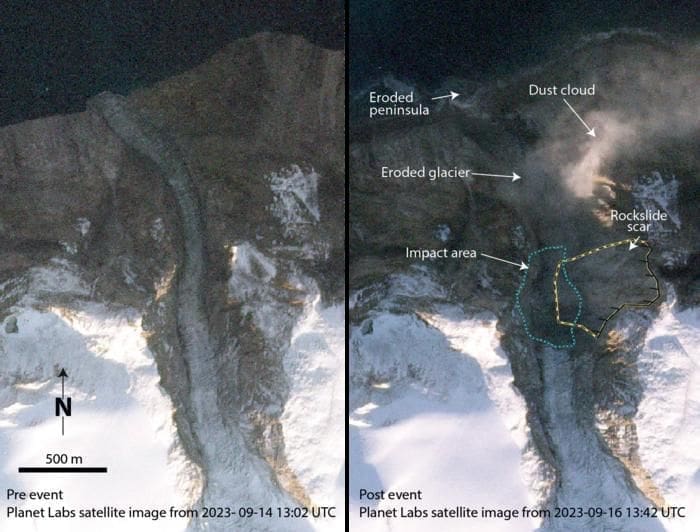A landslide in Greenland’s remote Dickson Fjord triggered a rare seismic event, generating vibrations detectable worldwide for nine days, according to a study published in Science.

The event, which took place in September 2023, produced a massive tsunami and a unique seismic signal, surprising scientists across the globe.
The study, involving researchers from University College London (UCL) and other institutions, concluded that the collapse of a 1.2km-high mountain peak into the fjord caused a 200-meter-high backsplash of water, with waves initially reaching 110 meters. These waves, measured at four meters 70 kilometers away, sloshed back and forth for nine days in the narrow, twisting fjord, producing a global vibration.
The team used detailed mathematical models to demonstrate how this movement, with water oscillating every 90 seconds, matched the vibrations detected by seismometers across the planet. The mysterious seismic signal, identified as an “unidentified seismic object” (USO), baffled scientists at first because it differed from typical earthquake signatures by containing only a single oscillation frequency, akin to a hum.
Dr. Stephen Hicks from UCL Earth Sciences, one of the study’s co-authors, said: “When I first saw the seismic signal, I was completely baffled. Even though we know seismometers can record a variety of sources happening on Earth’s surface, never before has such a long-lasting, globally travelling seismic wave, containing only a single frequency of oscillation, been recorded.”

The event was linked to climate change.
The thinning of the glacier beneath the mountain, a result of rising temperatures, destabilized the rock-face, triggering the landslide. This marks the first observed landslide and tsunami in eastern Greenland, adding to growing evidence of climate change’s significant impacts in the region.
Lead author Dr. Kristian Svennevig of the Geological Survey of Denmark and Greenland (GEUS) noted: “When we set out on this scientific adventure, everybody was puzzled and no one had the faintest idea what caused this signal. All we knew was that it was somehow associated with the landslide. We only managed to solve this enigma through a huge interdisciplinary and international effort.”
The study brought together 68 scientists from 40 institutions in 15 countries, combining field data, satellite imagery, and advanced simulations to reconstruct the sequence of events.
The team estimated that 25 million cubic meters of rock and ice fell into the fjord, displacing enough water to fill 10,000 Olympic swimming pools. Their simulations revealed that, while the tsunami wave initially reached heights of 110 meters, it diminished to around seven meters within minutes, eventually settling to a few centimeters over the following days.
The tsunami, one of the largest in recent history, caused significant damage to a research base and archaeological sites in the area but spared any passing cruise ships that regularly traverse Greenland’s fjords.
The study underscores the increasing importance of monitoring previously stable regions for signs of massive landslide and tsunami events as climate change accelerates.
Co-author Thomas Forbriger from Karlsruhe Institute of Technology highlighted the role of global seismic networks in capturing such rare and long-lasting events, while Anne Mangeney from Université Paris Cité noted how the event pushed the boundaries of tsunami modeling methods: “We had to go to an unprecedentedly high numerical resolution to capture this long-duration event in Greenland. This opens up new avenues in the development of numerical methods for tsunami modelling.”
As the impacts of climate change intensify, early detection and analysis of such events may become crucial to preventing future disasters.
Journal Reference:
Kristian Svennevig et al. ‘A rockslide-generated tsunami in a Greenland fjord rang Earth for 9 days‘, Science 385, 1196-1205 (2024). DOI:10.1126/science.adm9247
Article Source:
Press Release/Material by University College London
Featured image credit: Bjoertvedt | CC BY-SA 3.0 via Wikimedia Commons




